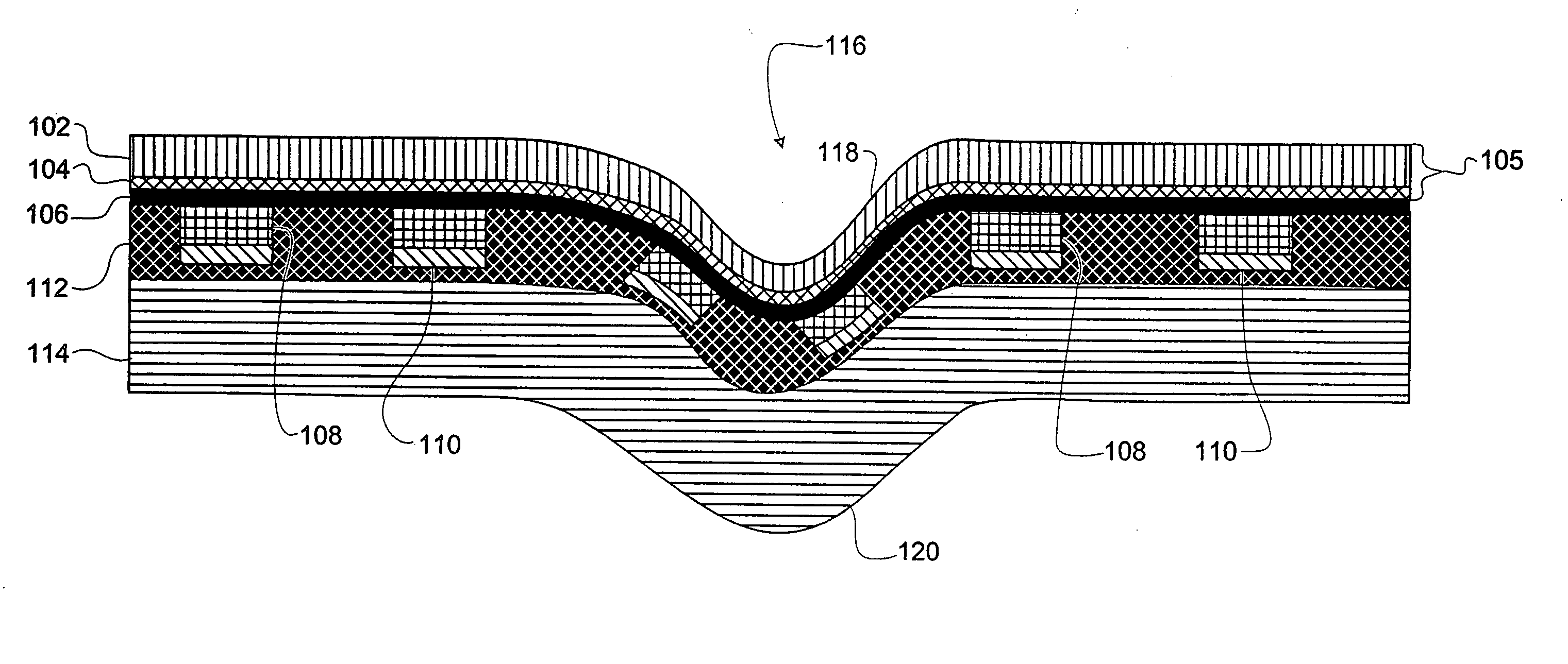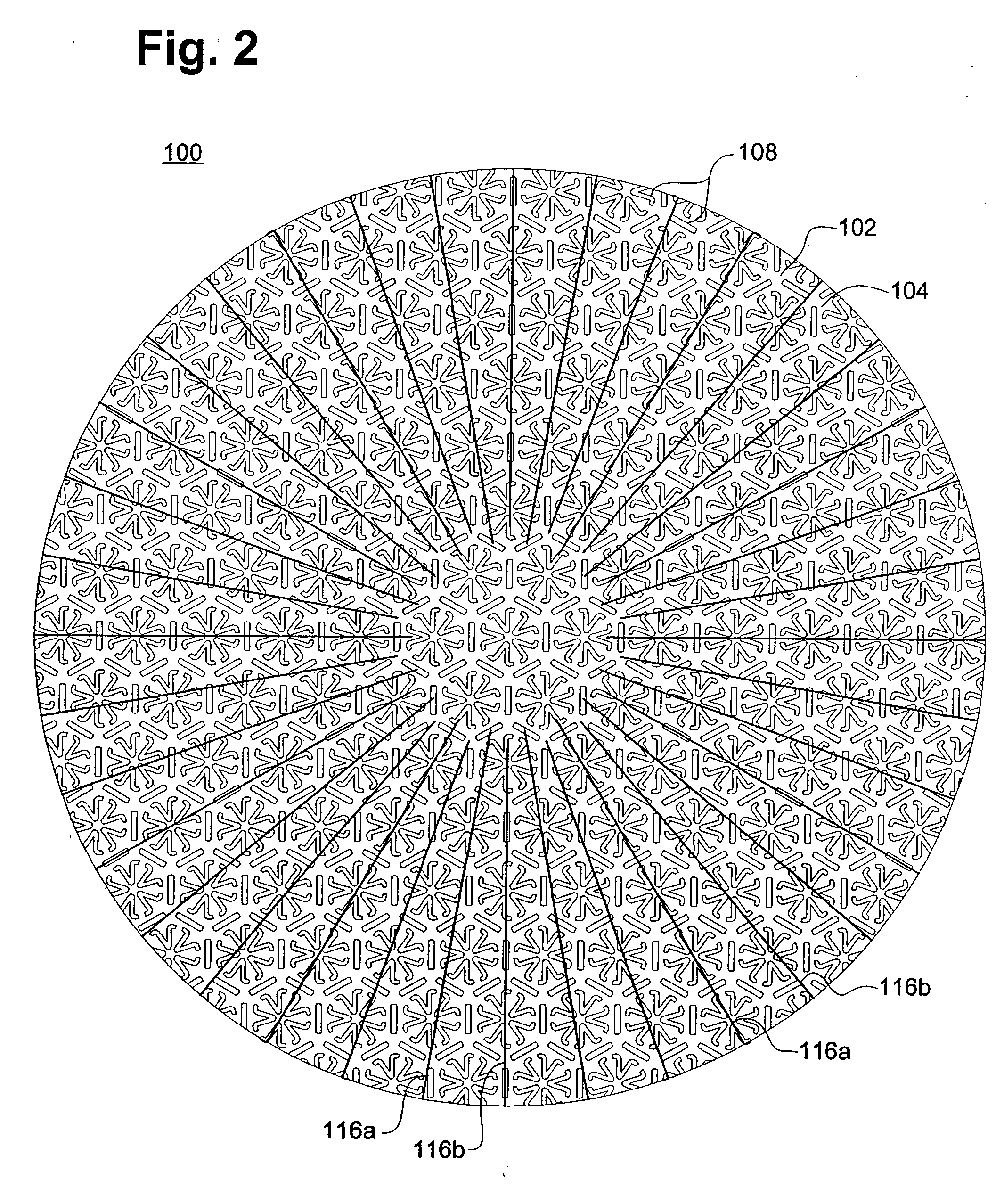Microwave packaging with indentation patterns
a technology of indentation patterns and microwave packaging, which is applied in the direction of packaging foodstuffs, packaged goods, electric/magnetic/electromagnetic heating, etc., can solve the problems of lessening the ability of microwave packaging materials to augment heating and browning of food products, and achieve enhanced cooking results and enhanced cooking power
- Summary
- Abstract
- Description
- Claims
- Application Information
AI Technical Summary
Benefits of technology
Problems solved by technology
Method used
Image
Examples
first embodiment
[0063] In a first embodiment, a blanking die, which normally comprises a sharp cutting edge to cut out the desired shape of a packaging blank from sheets of material or from a web, may be further formed with blunt scoring edges. The blunt edges score indentation lines in the microwave packaging material according to any of numerous patterns that may be designed to provide tailored cooking enhancements for the particular food product being cooked. In this embodiment, the scored indentation lines are formed simultaneously while the shape of the packaging is blanked by the sharp edges of the die. The creation of such dies is relatively inexpensive and the integration or substitution of a die into the manufacturing process is relatively simple. The lines of indentation patterns according to the present invention are generally on the order of 0.5 mm to 1 mm wide, but may be narrower or wider, for example, up to 2-3 mm wide, depending upon the desired effect. The width of the indentation ...
second embodiment
[0064] In a second embodiment, the scoring process may be applied to individual packaging blanks after they have been cut from the laminate web. The indentations may be impressed in a single action, for example, by using a die with blunt scoring edges formed in the desired pattern. The indentions may likewise be scored by multiple passes with a blunt scoring edge or an array of scoring edges. Any other scoring process may likewise be used to create the indentations in the microwave packaging material.
third embodiment
[0065] In a third embodiment, the indentation lines may be formed by placing the pre-cut microwave packaging blank into a forming mold with male and female sides that mate to create the desired indentation pattern upon the application of pressure. The use of a forming mold is a preferred method when the microwave package is to be, for example, a tray with sidewalls. In this circumstance, the tray is generally formed by compressing a flat blank of microwave packaging material in a mold to thrust portions of the blank into sidewalls of the tray. By additionally fabricating the mold with the indentation pattern protruding in relief from the male side of the mold and a symmetrical groove pattern on the female side of the mold, the indentation pattern in the microwave packaging material may be formed at the same time the tray is pressed. The use of a forming mold may be preferred when deep or wide indentation patterns are desired. In these circumstances the forming mold exerts less stres...
PUM
 Login to View More
Login to View More Abstract
Description
Claims
Application Information
 Login to View More
Login to View More - R&D
- Intellectual Property
- Life Sciences
- Materials
- Tech Scout
- Unparalleled Data Quality
- Higher Quality Content
- 60% Fewer Hallucinations
Browse by: Latest US Patents, China's latest patents, Technical Efficacy Thesaurus, Application Domain, Technology Topic, Popular Technical Reports.
© 2025 PatSnap. All rights reserved.Legal|Privacy policy|Modern Slavery Act Transparency Statement|Sitemap|About US| Contact US: help@patsnap.com



